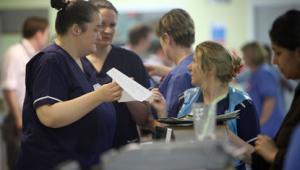By David Williams
06 August 2009
Nurses have warned they face ‘unsustainable pressure’ after official data showed NHS staff vacancy rates in the NHS have risen for the first time in five years.
Figures published by the NHS Information Centre show that both long-term and overall vacancy rates in most staff groups are higher in 2009 than the year before.
The annual survey, which provides a snapshot of the service on March 31, showed that the amount of long-term vacancies – empty posts left unfilled for three months or more – now accounts for 20% of the total.
For nursing staff, total vacancies rose from 2.5% in 2008 to 3.1%. Long-term vacancies are now 0.7%, up from 0.5% a year ago.
Among hospital doctors and dentists, the vacancy rate rose from 3.6% in 2008 to 5.2% in 2009, with long-term vacancies rising from 0.9% to 1.5%.
Overall vacancies among psychiatric nurses fell slightly, but the long-term rate still increased from 0.5% to 0.7%. Vacancies among GPs are broadly static.
Although vacancy levels have risen, they are still lower over than in 2006 or before.
Peter Carter, chief executive of the Royal College of Nursing, described the news as ‘worrying’.
‘While we are concerned about long-term vacancies, even unfilled short-term vacancies leave nurses under unsustainable pressure and, with higher workloads, too busy to provide the standard of care they would like,’ he said.
He said the increase was due to a combination of more nurses retiring, fewer coming into the profession from training schemes, and changes in migration policies, which restrict recruitment of nurses from outside of the European Union.
‘Unfortunately, today’s statistics are likely to mask the real picture of even higher vacancies, said Carter. ‘If a trust does not “actively” recruit for a post then they do not declare it vacant and it isn’t counted in the vacancy data.’
‘There is a worrying mismatch between rising levels of health care demand and the numbers of nurses in post needed to give patients quality care.
A spokesman for NHS Employers pointed out the service’s workforce is the biggest it has ever been, and increased by 40,000 last year.
‘NHS organisations face many challenges particularly in the current economic climate and it remains essential to retain staffing levels and ensuring a skilled workforce.
‘A rise in advertised vacancies could be expected as one of the steps necessary in anticipation of the European Working Time Directive, and reflecting additional £310 million funding for that purpose,’ he added.
06 August 2009
Nurses have warned they face ‘unsustainable pressure’ after official data showed NHS staff vacancy rates in the NHS have risen for the first time in five years.
Figures published by the NHS Information Centre show that both long-term and overall vacancy rates in most staff groups are higher in 2009 than the year before.
The annual survey, which provides a snapshot of the service on March 31, showed that the amount of long-term vacancies – empty posts left unfilled for three months or more – now accounts for 20% of the total.
For nursing staff, total vacancies rose from 2.5% in 2008 to 3.1%. Long-term vacancies are now 0.7%, up from 0.5% a year ago.
Among hospital doctors and dentists, the vacancy rate rose from 3.6% in 2008 to 5.2% in 2009, with long-term vacancies rising from 0.9% to 1.5%.
Overall vacancies among psychiatric nurses fell slightly, but the long-term rate still increased from 0.5% to 0.7%. Vacancies among GPs are broadly static.
Although vacancy levels have risen, they are still lower over than in 2006 or before.
Peter Carter, chief executive of the Royal College of Nursing, described the news as ‘worrying’.
‘While we are concerned about long-term vacancies, even unfilled short-term vacancies leave nurses under unsustainable pressure and, with higher workloads, too busy to provide the standard of care they would like,’ he said.
He said the increase was due to a combination of more nurses retiring, fewer coming into the profession from training schemes, and changes in migration policies, which restrict recruitment of nurses from outside of the European Union.
‘Unfortunately, today’s statistics are likely to mask the real picture of even higher vacancies, said Carter. ‘If a trust does not “actively” recruit for a post then they do not declare it vacant and it isn’t counted in the vacancy data.’
‘There is a worrying mismatch between rising levels of health care demand and the numbers of nurses in post needed to give patients quality care.
A spokesman for NHS Employers pointed out the service’s workforce is the biggest it has ever been, and increased by 40,000 last year.
‘NHS organisations face many challenges particularly in the current economic climate and it remains essential to retain staffing levels and ensuring a skilled workforce.
‘A rise in advertised vacancies could be expected as one of the steps necessary in anticipation of the European Working Time Directive, and reflecting additional £310 million funding for that purpose,’ he added.




















